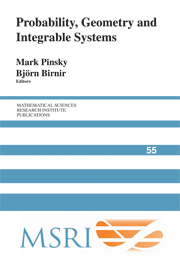Book contents
- Frontmatter
- Contents
- Preface
- Henry McKean: A tribute by the editors
- Bitangential direct and inverse problems for systems of differential equations
- Turbulence of a unidirectional flow
- Riemann–Hilbert problem in the inverse scattering for the Camassa–Holm equation on the line
- The Riccati map in random Schrödinger and random matrix theory
- SLE6and CLE6 from critical percolation
- Global optimization, the Gaussian ensemble, and universal ensemble equivalence
- Stochastic evolution of inviscid Burgers fluid
- A quick derivation of the loop equations for random matrices
- Singular solutions for geodesic flows of Vlasov moments
- Reality problems in the soliton theory
- Random walks and orthogonal polynomials: some challenges
- Integration of pair flows of the Camassa–Holm hierarchy
- Landen Survey
- Lines on abelian varieties
- Integrable models of waves in shallow water
- Nonintersecting Brownian motions, integrable systems and orthogonal polynomials
- Homogenization of random Hamilton–Jacobi–Bellman Equations
Riemann–Hilbert problem in the inverse scattering for the Camassa–Holm equation on the line
Published online by Cambridge University Press: 27 June 2025
- Frontmatter
- Contents
- Preface
- Henry McKean: A tribute by the editors
- Bitangential direct and inverse problems for systems of differential equations
- Turbulence of a unidirectional flow
- Riemann–Hilbert problem in the inverse scattering for the Camassa–Holm equation on the line
- The Riccati map in random Schrödinger and random matrix theory
- SLE6and CLE6 from critical percolation
- Global optimization, the Gaussian ensemble, and universal ensemble equivalence
- Stochastic evolution of inviscid Burgers fluid
- A quick derivation of the loop equations for random matrices
- Singular solutions for geodesic flows of Vlasov moments
- Reality problems in the soliton theory
- Random walks and orthogonal polynomials: some challenges
- Integration of pair flows of the Camassa–Holm hierarchy
- Landen Survey
- Lines on abelian varieties
- Integrable models of waves in shallow water
- Nonintersecting Brownian motions, integrable systems and orthogonal polynomials
- Homogenization of random Hamilton–Jacobi–Bellman Equations
Summary
We present a Riemann-Hilbert problem formalism for the initial value problem for the Camassa-Holm equation ut-utxx + 2ωux + 3uux= 2uxuxx + uuxxx on the line (CH), where ω is a positive parameter. We show that, for all ω > 0, the solution of this initial value problem can be obtained in a parametric form from the solution of some associated Riemann-Hilbert problem; that for large time, it develops into a train of smooth solitons; and that for small ω, this soliton train is close to a train of peakons, which are piecewise smooth solutions of the CH equation for ω = 0
1. Introduction
The main purpose of this paper is to develop an inverse scattering approach, based on an appropriate Riemann–Hilbert problem formulation, for the initial value problem for the Camassa–Holm (CH) equation [Camassa and Holm 1993] on the line, whose form is where ω is a positive parameter. The CH equation is a model equation describing the shallow-water approximation in inviscid hydrodynamics. In this equation u = u(x, t) is a real-valued function that refers to the horizontal fluid velocity along the x direction (or equivalently, the height of the water's free surface above a flat bottom) as measured at time t . The constant ω is related to the critical shallow water wave speed, where g is the acceleration of gravity and h0 is the undisturbed water depth; hence, the case ω >0 is physically more relevant than the case ω = 0, though the latter has attracted more attention in the mathematical studies due to interesting specific features such as the existence of peaked (nonanalytic) solitons.
Information
- Type
- Chapter
- Information
- Probability, Geometry and Integrable Systems , pp. 53 - 76Publisher: Cambridge University PressPrint publication year: 2008
Accessibility standard: Unknown
Why this information is here
This section outlines the accessibility features of this content - including support for screen readers, full keyboard navigation and high-contrast display options. This may not be relevant for you.Accessibility Information
- 1
- Cited by
